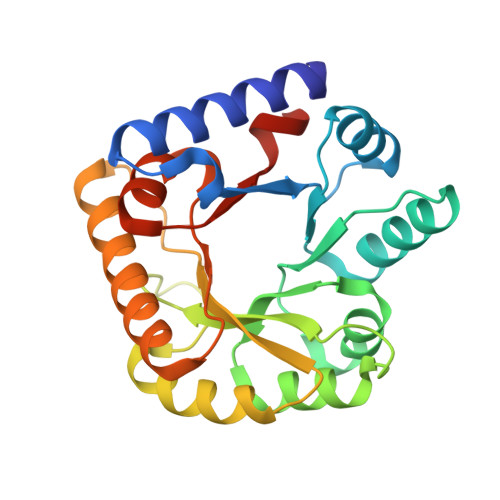Characterization of the Escherichia coli pyridoxal 5'-phosphate homeostasis protein (YggS): Role of lysine residues in PLP binding and protein stability.
Tramonti, A., Ghatge, M.S., Babor, J.T., Musayev, F.N., di Salvo, M.L., Barile, A., Colotti, G., Giorgi, A., Paredes, S.D., Donkor, A.K., Al Mughram, M.H., de Crecy-Lagard, V., Safo, M.K., Contestabile, R.(2022) Protein Sci 31: e4471-e4471
- PubMed: 36218140
- DOI: https://doi.org/10.1002/pro.4471
- Primary Citation of Related Structures:
7U9C, 7U9H, 7UAT, 7UAU, 7UAX, 7UB4, 7UB8, 7UBP, 7UBQ - PubMed Abstract:
The pyridoxal 5'-phosphate (PLP) homeostasis protein (PLPHP) is a ubiquitous member of the COG0325 family with apparently no catalytic activity. Although the actual cellular role of this protein is unknown, it has been observed that mutations of the PLPHP encoding gene affect the activity of PLP-dependent enzymes, B 6 vitamers and amino acid levels. Here we report a detailed characterization of the Escherichia coli ortholog of PLPHP (YggS) with respect to its PLP binding and transfer properties, stability, and structure. YggS binds PLP very tightly and is able to slowly transfer it to a model PLP-dependent enzyme, serine hydroxymethyltransferase. PLP binding to YggS elicits a conformational/flexibility change in the protein structure that is detectable in solution but not in crystals. We serendipitously discovered that the K36A variant of YggS, affecting the lysine residue that binds PLP at the active site, is able to bind PLP covalently. This observation led us to recognize that a number of lysine residues, located at the entrance of the active site, can replace Lys36 in its PLP binding role. These lysines form a cluster of charged residues that affect protein stability and conformation, playing an important role in PLP binding and possibly in YggS function.
Organizational Affiliation:
Istituto di Biologia e Patologia Molecolari, Consiglio Nazionale delle Ricerche, Rome, Italy.















